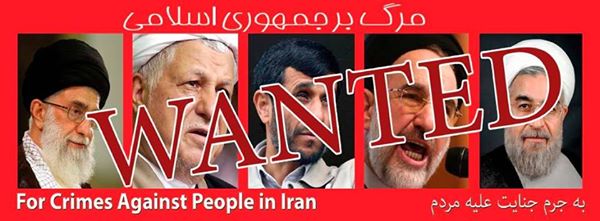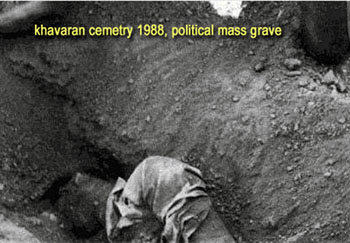The list of 4483 political prisoners who were executed during the massacre of 1988 by the Islamic regime in IRAN
The list of 4483 political prisoners1
The list of 4483 political prisoners who were executed during2
The list of 4483 political prisoners3
The list of 4483 political prisoners4
The list of 4483 political prisoners5
The list of 4483 political prisoners who were executed during6
The list of 4483 political prisoners who were executed during7
The list of 4483 political prisoners who were executed during8-1
Zainab Jalalian political prisoner in Iran.
Zainab Jalalian was arrested in July of 2007 in the Kurdish province of Kermanshah for allegedly being a member of a banned Kurdish opposition group of insurgents. She was initially taken to the detention center of Ministry of Intelligence, where she was tortured for eight months. As a result, Zainab Jalalian began to suffer from internal and intestinal bleeding. Two years after her arrest, in a trial that lasted only minutes, with no legal representation, she was accused of “waging war against God” and, at age 27, was sentenced to death. In 2010 she was transferred to the feared Ward 209 of Evin prison in Tehran, a section well known for torturing prisoners until they confess. There she was told that her death sentence would be lifted if she agreed to a televised confession admitting her “armed” involvement against the regime. She endured by maintaining her innocence and refused their demand. She was then transferred back to Kermanshah facilities to await execution.
In a letter shortly after she was sentenced to death in 2009, Zainab Jalalian wrote the following:
“…I am currently ill because of torture and I don’t have any lawyer to defend me. I want to tell you that my trial took only few minutes. The court told me: ‘You are an enemy of God. You must be hanged very soon.’ That was the sum of my entire court process. I asked the judge to give me permission to just say good-bye to my mother before my execution. He told me to ‘shut up’ and rejected my request.” — November 2009,
According to report from group in Iran working with human rights issue,Zainab Jalalian was passed around like a soccer ball between male guards while she was tied up, blindfolded and beaten. In the first three months of her detention, she suffered such serious head injuries that her interrogators, in a rare and unusual act, were forced to transfer her to a hospital outside prison. The report also reveals that she was also flogged on the soles of her feet until she passed out. When she finally gained consciousness; she was forced to walk on her feet and was then flogged again. She was also threatened with rape by her interrogator; she protested, he then struck her on the head with an iron rod, which fractured her skull, causing her to bleed profusely. It is believed it was this blow, along with many more repeated blows to her head, affected her vision; she was consistently denied medical care for her injuries, despite many hunger strikes. She became blind in both eyes.
Between 2009 and 2010, Zainab Jalalian was the subject of an international campaign against her execution. As a direct result, her death sentence was commuted to life in prison. Zainab Jalalian is presently in agonizing pain due to bleeding and infection of her intestines. The authorities are deliberately refraining from transferring her to a city hospital for proper treatment. She has been given no provisions for her blindness while serving time. Both her ailments are direct result of torture while in custody.
Massacres of Political Prisoners in the 1980s by the capitalist – Islamic regime of Iran
After the change of regime in Iran in February 1979, the Islamic regime took over power. But in reality, it was just a change from monarchy dictatorship to Islamic dictatorship. Oppression, imprisonment, torture and execution continued.
The Iranian people’s uprising against the Shah-regime was put down and their demands were attacked. Likewise, from the first day of the Islamic regime in power, all demands of the people, for instance, for freedom, democracy, equality etc. were suppressed.
The Kurdish people were attacked and bombarded. Other minorities like Turkmen, Baluche, Arabs, Lor, etc. were attacked as well and many of them were killed by the Islamic forces. During the uprising, Iranian workers had formed various workers’ councils, but these were closed down by the regime. Workers were as heavily oppressed as during the Shah regime. Iranian women fighting for equality and freedom, were attacked as one of the first groups in society. In history, Iranian students and universities had always played an important role in society against dictatorship, but the Islamic regime closed universities as well as students’ organisations ” in the name of the Islamic cultural revolution”. Many students were killed. Universities were closed from 1980 until 1983.
Freedom of speech – one of the slogans of the uprising against the shah regime – has been continuously oppressed by the Islamic regime. All newspapers were closed down and forbidden, and the right to organize, demonstrate, strike etc. was forbidden.
Political organizations and parties that were against the shah regime have been persecuted and forbidden from the first day of the Islamic regime, and many of the members and supporters were sent to jail, tortured and executed.
With the start of the war between the two reactionary regimes of Iraq and Iran in 1980, the Islamic regime found a new excuse to oppress all movements: accusing of collaboration with the enemies – for instance at demonstrations, strikes etc.
In 1981, when the Islamic regime had been two years in power, beside the military and intelligence services (Savak) of the Shah, various Islamic military (Pasdaran) and intelligence services (Savama) were organised. From this period the regime intensified mass imprisonment, torture, executions, oppression etc.
At the beginning of 1981, one of the biggest massacres in Iranian history took place. Thousands of political prisoners were executed or tortured by the Islamic regime. Every day and every night, a lot of executions were carried out.
The judicial system was headed by mullahs (Islamic priests). Political prisoners were called in for a so called trial in which just one mullah asked three or four questions : name, party/ organization, Will you condemn your party/ organization? or Will you collaborate and participate in an interview on television and say you regret, and you believe in islam etc.).
Thousands of them were sentenced to execution and others to long imprisonment. In prison, the interrogation and torture continued all the time because the Islamic laws say prisoners must apologise and accept islam. Female political prisoners have obtained equality by Islamic laws – as for torture and execution. Many female political prisoners were raped in prison, and many of them raped just before execution, because – according to Islamic rules – if you are a virgin and you die, you are going to paradise.
From 1981 until 1988, tens of thousands of political prisoners were executed or killed under torture in prison by the Islamic regime. In 1988, after the end of the war between Iran and Iraq, and after the Islamic regime’s accept of UN resolution 598, Khomeini, leader of the Islamic regime, ordered to “clean up” the prisons in Iran. In a letter he sent to the responsible for the Islamic judicial system, he ordered the execution of the political prisoners.
In August and September 1988, according to the order of Khomeini, a “death commission” consisting of five members was established. They went to different prisons, for instance the Evin prison in Tehran and Gohardasht prison and called the political prisoners to so called courts. The prisoners were interrogated for two-three minutes: Do you believe in islam? Do you believe in your organization or party? Will you cooperate and make an interview on television? If the answer did not satisfy the death commission, the political prisoners were sent directly to be hanged or executed. The Marxist women according to Islamic laws – in this so called court – had to accept to pray, or if they did not accept to pray, they were lashed to death or until they accepted to do so. But many of the female political prisoners did not accept to pray and died.
After the massacres of the political prisoners in 1988, the Islamic regime buried all the bodies of the executed prisoners in mass graves in different places, for example in Tehran at the cemetery called Khavaran. The Islamic regime until now has not admitted these crimes, but the names of almost 5000 executed prisoners and the names of their organizations or parties are known.
Families and relatives of the political prisoners who were executed in 1988 did not get the bodies and they were not told where the bodies were buried. Some of them just got some clothes and from 1988 until to-day they are not allowed to commemorate their relatives.
Until now the world does not know about the massacres of the political prisoners in Iran in 1980’s – one of the biggest massacres in world history. We – as part of the revolutionary – communist resistance movements against the Islamic regime in Iran – call for international condemnation of the massacres and the Islamic regime and for solidarity with the resistance in Iran.
Overthrow the capitalist – Islamic regime in Iran – Long live socialism
International Committee for Support of Political Prisoners in Iran
Stop Executions Now
Mumia Abu-Jamal – first interview since escaping death row
Hanging of political prisoners in the street by the Islamic regime in Iran
Khavaran cemetry 1988, the mass grave of political prisoners
From Death Row, Mumia Abu Jamal (3/3)
From Death Row, Mumia Abu Jamal (2/3)






